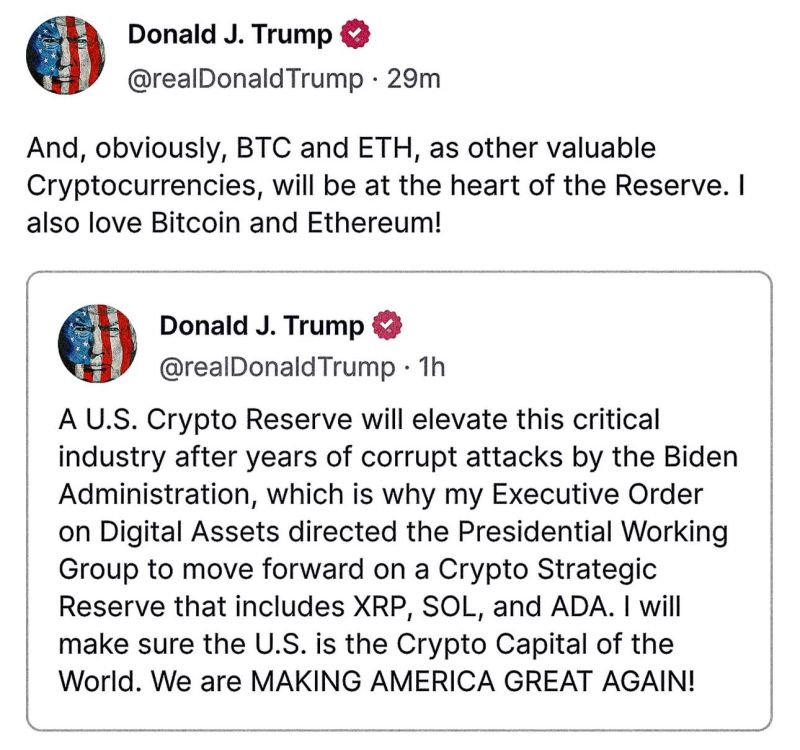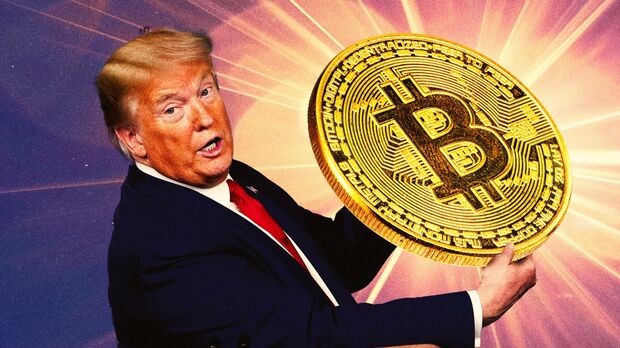
President Donald Trump’s announcement of a U.S. Crypto Strategic Reserve marks a watershed moment in the integration of digital assets into national economic strategy. By directing the Presidential Working Group on Digital Assets to establish a reserve comprising Bitcoin (BTC), Ethereum (ETH), XRP, Solana (SOL), and Cardano (ADA), the administration has catalyzed a $300 billion global crypto market rally while signaling a paradigm shift in how governments interact with blockchain-based assets1611. This initiative repositions the U.S. as a proactive player in the crypto economy, transitioning from regulatory skepticism under the Biden administration to strategic accumulation and institutionalization of digital assets312. While altcoins like XRP and ADA saw immediate price surges exceeding 60%, Bitcoin’s structural advantages as a politically neutral, liquid store of value position it as the ultimate beneficiary of this policy shift815.
The Mechanics of the Crypto Strategic Reserve
From Asset Seizures to Sovereign Holdings
The U.S. government currently holds approximately $17 billion in Bitcoin seized through law enforcement actions, including the Silk Road confiscation and Bitfinex hack recovery613. Historically, these assets were liquidated via auctions managed by the U.S. Marshals Service (USMS), with proceeds directed to Treasury funds27. Trump’s executive order fundamentally alters this approach by:
- Halting forced sales: The USMS will retain seized cryptocurrencies rather than auctioning them, eliminating a source of market sell pressure615.
- Expanding custody infrastructure: The Department of Justice is partnering with institutional custodians like JP Morgan to securely manage reserves, addressing the USMS’s documented struggles with tracking crypto holdings715.
- Strategic accumulation: The working group will establish criteria for actively acquiring cryptocurrencies beyond seized assets, potentially including direct purchases using Treasury funds311.
This phased approach mirrors the evolution of gold reserves in the 20th century, where passive stockpiling gradually gave way to active acquisition as part of monetary policy413.
Bitcoin’s Structural Dominance in Reserve Strategy
Liquidity and Institutional Adoption
While the initial announcement triggered outsized gains for XRP (+62%) and ADA (+60%), Bitcoin’s $94,220 price (+10%) reflects its unique role as the only cryptoasset with sufficient liquidity for large-scale sovereign transactions812. The U.S. government’s existing BTC holdings—representing 0.94% of the total 21 million supply—already exceed the gold reserves of Switzerland’s central bank13. Transitioning to active accumulation would require deploying capital at scale, a feat only feasible through Bitcoin’s $1.2 trillion market depth46.
Political Neutrality vs. Regulatory Capture
Trump’s inclusion of XRP and SOL—projects with ongoing SEC litigation and centralized governance—introduces geopolitical risk absent from Bitcoin’s decentralized network815. Analysts at Farringdon Capital Management note that Bitcoin’s “digital gold” narrative aligns with reserve asset characteristics: scarcity (21M cap), censorship resistance, and apolitical issuance4. By contrast, Ethereum’s transition to proof-of-stake and Solana’s reliance on venture capital funding create regulatory attack surfaces that could complicate long-term reserve status58.
Regulatory Reconfiguration Under Trump
Dismantling the Biden Framework
The Biden administration’s 2023 Executive Order 14067 established strict capital gains reporting, anti-money laundering (AML) protocols, and limitations on bank crypto custody. Trump’s policies reverse this trajectory through:
- Deregulation of institutional custody: Banks and asset managers can now hold crypto reserves, with BlackRock and Fidelity emerging as leading custodians.
- Stablecoin clarity: The working group will propose legislation recognizing USD-pegged stablecoins as payment instruments, reducing reliance on Tether’s offshore issuance.
- Tax incentives: Plans to exempt crypto-to-crypto trades from capital gains taxation mirror Singapore’s pro-growth framework.
These changes have already attracted $24 billion in institutional inflows to Bitcoin ETFs since January 2025, according to Arrington Capital.
Global Implications and Market Calculus
The Dollar’s New Anchor
By collateralizing dollar issuance with Bitcoin reserves, the U.S. could theoretically mitigate fiat inflation risks—a strategy first proposed by economist Saifedean Ammous in The Bitcoin Standard. While direct money printing for BTC purchases remains speculative, Treasury Secretary David Sacks has acknowledged studying “balance sheet diversification” using cryptoassets.
Cascading Sovereign Adoption
The U.S. move pressures other nations to accelerate reserve diversification:
- European Union: ECB President Christine Lagarde has convened emergency talks on digital asset reserves.
- China: PBOC researchers published a white paper exploring Bitcoin mining’s role in renewable energy grid stabilization.
- Emerging Markets: Nigeria and Argentina are drafting legislation to recognize Bitcoin as legal tender, following El Salvador’s 2024 precedent.
Risks and Operational Challenges
Custodial Vulnerabilities
The USMS’s inability to accurately track its existing Bitcoin holdings—revealed in February 2025 court filings—highlights systemic risks in government crypto management. Proposed solutions include:
- Multi-sig vaults: Utilizing 3-of-5 signature schemes with keys held by Federal Reserve, Treasury, and certified custodians.
- On-chain transparency: Public blockchain monitoring tools like Arkham Intelligence to audit reserves in real-time.
Market Distortion
Concentrated government buying could manipulate prices, particularly for low-liquidity assets like ADA. Bitcoin’s $23 billion daily trading volume provides a buffer against such distortions, unlike Solana’s $2.4 billion volume.
Strategic Recommendations for Investors
- Bitcoin-Centric Exposure: Allocate 60-70% of crypto portfolios to BTC via spot ETFs (IBIT, FBTC) or direct custody solutions.
- Altcoin Caution: Treat SOL and ADA positions as tactical trades (<10% allocation) given regulatory uncertainties.
- Geographic Diversification: Consider jurisdictions like Dubai and Singapore advancing pro-Bitcoin regulatory frameworks.
Conclusion: The New Monetary Architecture
The Crypto Strategic Reserve initiative represents the most significant development in monetary policy since the 1971 Nixon Shock ended gold convertibility. By aligning Treasury strategy with Bitcoin’s apolitical scarcity, the U.S. aims to reinforce dollar hegemony in a multipolar financial world. While altcoins may benefit from short-term speculation, Bitcoin’s deep liquidity, institutional infrastructure, and resistance to regulatory capture cement its role as the cornerstone of 21st-century reserve portfolios. As Trump prepares to host the inaugural White House Crypto Summit on March 7, market participants should position for increased volatility and accelerated institutional adoption.
“Bitcoin is the first tool in history through which absolute scarcity can be enforced at a global scale. The U.S. reserve strategy validates this property as a foundation for modern finance.”

No responses yet